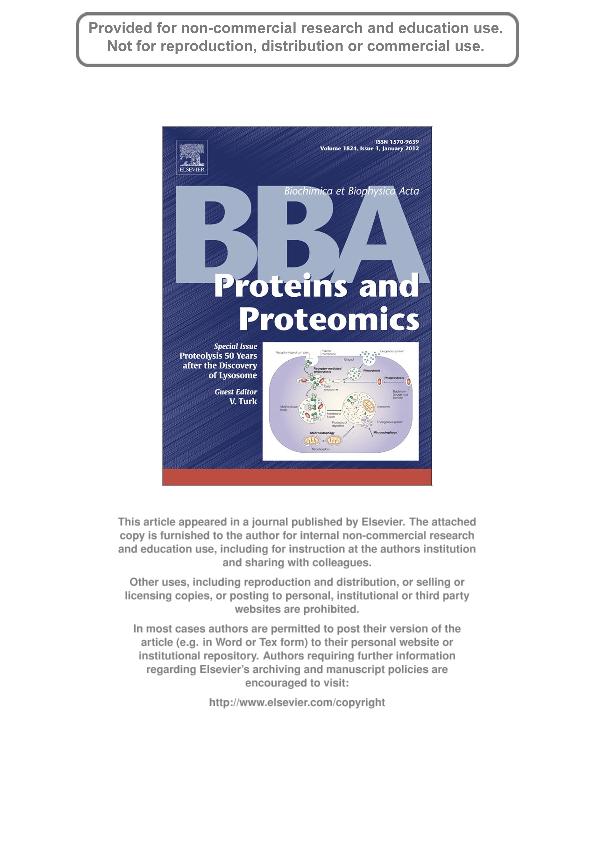Mostrar el registro sencillo del ítem
dc.contributor.author
Alvarez, Vanina Eder

dc.contributor.author
Niemirowicz, Gabriela Teresa

dc.contributor.author
Cazzulo, Juan Jose

dc.date.available
2019-05-09T18:23:21Z
dc.date.issued
2012-01
dc.identifier.citation
Alvarez, Vanina Eder; Niemirowicz, Gabriela Teresa; Cazzulo, Juan Jose; The peptidases of Trypanosoma cruzi: digestive enzymes, virulence factors, and mediators of autophagy and programmed cell death; Elsevier Science; Biochimica Et Biophysica Acta-proteins And Proteomics; 1824; 1; 1-2012; 195-206
dc.identifier.issn
1570-9639
dc.identifier.uri
http://hdl.handle.net/11336/75983
dc.description.abstract
Trypanosoma cruzi, the agent of the American Trypanosomiasis, Chagas disease, contains cysteine, serine, threonine, aspartyl and metallo peptidases. The most abundant among these enzymes is cruzipain, a cysteine proteinase expressed as a mixture of isoforms, some of them membrane-bound. The enzyme is an immunodominant antigen in human chronic Chagas disease and seems to be important in the host/parasite relationship. Inhibitors of cruzipain kill the parasite and cure infected mice, thus validating the enzyme as a very promising target for the development of new drugs against the disease. In addition, a 30 kDa cathepsin B-like enzyme, two metacaspases and two autophagins have been described. Serine peptidases described in the parasite include oligopeptidase B, a member of the prolyl oligopeptidase family involved in Ca 2+- signaling during mammalian cell invasion; a prolyl endopeptidase (Tc80), against which inhibitors are being developed, and a lysosomal serine carboxypeptidase. Metallopeptidases homologous to the gp63 of Leishmania spp. are present, as well as two metallocarboxypeptidases belonging to the M32 family, previously found only in prokaryotes. The proteasome has properties similar to those of other eukaryotes, and its inhibition by lactacystin blocks some differentiation steps in the life cycle of the parasite. This article is part of a Special Issue entitled: Proteolysis 50 years after the discovery of lysosome. © 2011 Elsevier B.V. All rights reserved.
dc.format
application/pdf
dc.language.iso
eng
dc.publisher
Elsevier Science

dc.rights
info:eu-repo/semantics/openAccess
dc.rights.uri
https://creativecommons.org/licenses/by-nc-sa/2.5/ar/
dc.subject
Autophagins
dc.subject
Chagas Disease
dc.subject
Cruzipain
dc.subject
Metacaspases
dc.subject
Peptidases
dc.subject
Trypanosoma Cruzi
dc.subject.classification
Bioquímica y Biología Molecular

dc.subject.classification
Ciencias Biológicas

dc.subject.classification
CIENCIAS NATURALES Y EXACTAS

dc.title
The peptidases of Trypanosoma cruzi: digestive enzymes, virulence factors, and mediators of autophagy and programmed cell death
dc.type
info:eu-repo/semantics/article
dc.type
info:ar-repo/semantics/artículo
dc.type
info:eu-repo/semantics/publishedVersion
dc.date.updated
2019-05-08T18:26:05Z
dc.journal.volume
1824
dc.journal.number
1
dc.journal.pagination
195-206
dc.journal.pais
Países Bajos

dc.journal.ciudad
Amsterdam
dc.description.fil
Fil: Alvarez, Vanina Eder. Consejo Nacional de Investigaciones Científicas y Técnicas. Centro Científico Tecnológico Conicet - La Plata. Instituto de Investigaciones Biotecnológicas. Universidad Nacional de San Martín. Instituto de Investigaciones Biotecnológicas; Argentina
dc.description.fil
Fil: Niemirowicz, Gabriela Teresa. Consejo Nacional de Investigaciones Científicas y Técnicas. Centro Científico Tecnológico Conicet - La Plata. Instituto de Investigaciones Biotecnológicas. Universidad Nacional de San Martín. Instituto de Investigaciones Biotecnológicas; Argentina
dc.description.fil
Fil: Cazzulo, Juan Jose. Consejo Nacional de Investigaciones Científicas y Técnicas. Centro Científico Tecnológico Conicet - La Plata. Instituto de Investigaciones Biotecnológicas. Universidad Nacional de San Martín. Instituto de Investigaciones Biotecnológicas; Argentina
dc.journal.title
Biochimica Et Biophysica Acta-proteins And Proteomics

dc.relation.alternativeid
info:eu-repo/semantics/altIdentifier/doi/http://dx.doi.org/10.1016/j.bbapap.2011.05.011
dc.relation.alternativeid
info:eu-repo/semantics/altIdentifier/url/https://www.sciencedirect.com/science/article/pii/S157096391100135X
Archivos asociados
